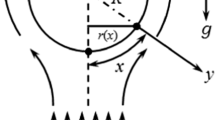Abstract
A free convertion flow of an optically dense viscous incompressible fluid along a vertical thin circular cylinder has been studied with effect of radiation when the surface temperature is uniform. With appropriate transformations, the boundary layer equations governing the flow are reduced to local nonsimilarity equations. Solutions of the governing equations are obtained employing the implicit finite difference methods together with Keller box scheme as well the local nonsimilarity method with second order truncation for all ξ (nondimensional transverse curvature parameter) in the interval [0,10] and are expressed in terms of local Nusselt number for a range of values of the pertinent parameters. Effects of pertinent parameters, such as, the radiation parameter, R d , the surface temperature parameter, θ w , taking Prandtl number, Pr, equals 0.7 on the velocity and temperature field are also presented graphically. From the solution it is seen that increase of R d , or θ w leads to increase in the local rate of heat transfer coefficients. Results obtained by both the methods are obtained in excellent agreement between each other upto ξ = 10.
Zusammenfassung
Die freie Konvektivströmung eines optisch dichten, zähen, inkompressiblen Fluids entlang eines dünnen, senkrechten Kreiszylinders wurde unter Berücksichtigung des Strahlungseinflusses bei konstanter Oberflächentemperatur untersucht. Durch geeignete Transformationen lassen sich die das Strömungsverhalten bestimmenden Grenzschichtgleichungen auf lokal nichtähnliche Gleichungen reduzieren und unter Verwendung eines impliziten Finitdifferenzen-Verfahrens und des Keller-Box Schemas lösen. Daneben wurde die lokale Nichtähnlichkeitsmethode mit einer Abbruchbedingung zweiter Ordnung für alle ξ (dimensionsloser Querkrümmungsparameter) im Intervall [0,10] eingesetzt. Lokale Nusselt-Zahlen, Geschwindigkeits- und Temperaturfelder sind in Abhängigkeit von den Hauptparametern R d (Strahlung), Θ w (Oberflächentemperatur) für Pr = 0,7 darstellt. Die Ergebnisse zeigen einen Anstieg der lokalen Wärmeübergangskoeffizienten bei wachsendem R d bzw. Θ w . Bis ξ = 10 lieferten beide Methoden sehr gut übereinstimmende Ergebnisse.
Similar content being viewed by others
Author information
Authors and Affiliations
Additional information
Received on 2 October 1996
Rights and permissions
About this article
Cite this article
Hossain, M., Alim, M. Natural convection-radiation interaction on boundary layer flow along a thin vertical cylinder. Heat and Mass Transfer 32, 515–520 (1997). https://doi.org/10.1007/s002310050153
Issue Date:
DOI: https://doi.org/10.1007/s002310050153



